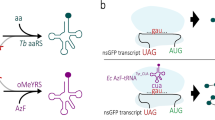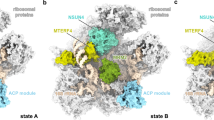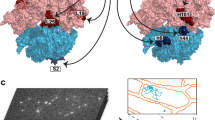Abstract
SEVERAL peptides are synthesised on mitochondrial chloramphenicol-sensitive ribosomes1. In the presence of cycloheximide (∼ 200 µg ml −1), amino acids are incorporated exclusively into mitochondrial proteins in Neurospora crassa2 and the flight muscle of Locusta migratoria3, leading to the generally accepted idea that mitochondrially synthesised proteins remain in the mitochondria. It is possible, however, that the high concentration of cycloheximide used in those experiments could inhibit any potential export of such proteins to other parts of the cell, particularly since the drug has been shown to affect several vital cellular processes independently of its effect on protein synthesis; for example, it stimulates the catabolism of nucleic acids and decreases intracellular ATP (ref. 4). This may explain some published indications of export of mitochondrially synthesised proteins in experiments in which cycloheximide was not used, such as the continued synthesis of myelin proteolipid in crude mitochondrial fractions of rat brain homogenates treated with RNase5; and the cytoplasmic location of the mutation in a line of Zea mays responsible for the susceptibility of its root plasma membrane K+-stimulated ATPase to the toxin of Helminthosporium maydis race T.6 We describe here observations on the incorporation of radioactivity into membranes of the post-mitochondrial supernatant of homogenates of N. crassa which had been pulsed with radioactive amino acids in the presence of cycloheximide (25 µg ml −1) then grown for 2h in drug- and label-free medium. We have been unable to account for this solely on the basis of mitochondrial fragmentation. Of the membranes present in the postmitochondrial supernatant, we have investigated in detail a microsomal fraction enriched for endoplasmic reticulum, as a first step in determining the nature of this incorporation.
This is a preview of subscription content, access via your institution
Access options
Subscribe to this journal
Receive 51 print issues and online access
$199.00 per year
only $3.90 per issue
Buy this article
- Purchase on Springer Link
- Instant access to full article PDF
Prices may be subject to local taxes which are calculated during checkout
Similar content being viewed by others
References
Schatz, G., & Mason, T. L. A. Rev. Biochem. 43, 51–87 (1974).
Sebald, W., Schwab, A. J. & Bucher, T. H. FEBS Lett. 4, 243–246 (1969).
Sebald, W., Hofstötter, T. H. & Hacker, D. FEBS Lett. 2, 177–180 (1968).
McMahon, D. Pl. Physiol. 55, 815–821 (1975).
Klee, C. B. & Solokoff, L. Proc. natn. Acad. Sci. U.S.A. 53, 1014–1021 (1965).
Tipton, C. L., Mondal, M. H. & Uhlig, J. Biochem. biophys. Res. Commun. 51, 725–728, (1973).
Lansman, R. A., Rowe, M. J. & Woodward, D. O. Eur. J. Biochem. 41, 15–23 (1972).
Lowry, E. H., Rosebrough, N. J., Farr, A. L. & Randall, R. J. J. Biol. Chem. 193, 265–275 (1951).
Fairbanks, G. T., Steck, L. & Wallach, D. F. H. Biochemistry 10, 2606–2617 (1971).
de Duve, C., Pressman, B. C., Gianetto, R., Wattiaux, R. & Applemans, F. Biochem. J. 60, 604–617 (1955).
van Gelder, B. F. Biochim. biophys. Acta 118, 36–46 (1966).
Swank, R. T. & Munkres, K. D. Analyt. Biochem. 39, 462–477 (1971).
Nenner, M., Niederwieser, A. & Pataki, G. in Thin Layer Chromatography (ed. Egon Stahl) 737 (Springer, New York, 1969).
Bray, G. A. Analyt. Biochem. 1, 279–285 (1960).
Kadenbach, B. Biochem. biophys. Res. Commun. 44, 724–730 (1971).
Dianoux, A.-C., Bof, M., Cesarini, R., Reboul, A. & Vignais, P. V. Eur. J. Biochem. 67, 61–66 (1976).
Skipski, V. P., Peterson, R. F. & Barclay, M. J. Lipid Res. 3, 467–475 (1962).
Bragden, J. H. in Lipids and the Steroid Hormones in Clinical Medicine (eds Funderman, F. W. & Funderman, F. W., Jr) (Lippincott, Philadelphia, 1960).
Johnson, J. D., King, N. L. & Benkley, F. J. Neurochem. 26, 361–367 (1976).
Barath, Z. & Kuntzel, H. Proc. natn. Acad. Sci. U.S.A. 69, 1371–1374 (1972).
Edwards, D. L., Rosenberg, E. & Maroney, P. A. J. biol. Chem. 249, 3551–3556 (1974).
Jagow, G., Weiss, H. & Klingenberg, M. Eur. J. Biochem. 33, 140–157 (1973).
Roa, R. C. & Bose, S. K. Proc. natn. Acad. Sci. U.S.A. 72, 4337–4340 (1975).
Clayton, D. A. & Vinograd, J. Nature 216, 652–657 (1967).
D'Agostino, M. A. & Nass, M. M. K. J. Cell Biol. 71, 781–794 (1976).
Author information
Authors and Affiliations
Rights and permissions
About this article
Cite this article
MACKLIN, W., MEYER, D., WOODWARD, D. et al. Chloramphenicol-sensitive labelling of protein in microsomes of Neurospora crassa. Nature 269, 447–450 (1977). https://doi.org/10.1038/269447a0
Received:
Accepted:
Issue Date:
DOI: https://doi.org/10.1038/269447a0
Comments
By submitting a comment you agree to abide by our Terms and Community Guidelines. If you find something abusive or that does not comply with our terms or guidelines please flag it as inappropriate.



